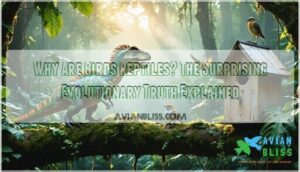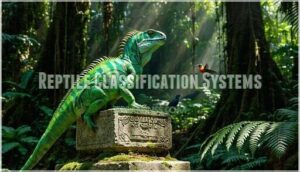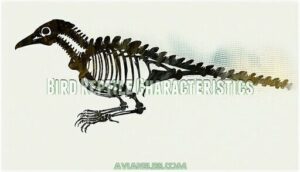This site is supported by our readers. We may earn a commission, at no cost to you, if you purchase through links.

Birds are classified as reptiles because they evolved directly from theropod dinosaurs around 150 million years ago.
Modern classification systems group organisms by evolutionary relationships, not just appearance—and birds share their most recent common ancestor with crocodiles, making them part of the reptile family tree.
This isn’t just theory; DNA evidence confirms birds are basically feathered dinosaurs with hollow bones, scaly feet, and egg-laying habits that scream "reptile."
The scientific community has embraced this connection, though it challenges our everyday thinking about these creatures soaring overhead.
Table Of Contents
- Key Takeaways
- Birds Evolution History
- Why Are Birds Reptiles
- Reptile Classification Systems
- Bird Reptile Characteristics
- Importance of Accurate Classification
- Frequently Asked Questions (FAQs)
- Why are birds considered flying reptiles?
- Why is a not a reptile?
- How are birds dinosaurs if they aren’t reptiles?
- Why are birds like reptiles?
- Why are birds classified as reptiles and not in their own class?
- When did birds become classified as reptiles?
- What sets birds apart from reptiles?
- Are birds considered reptiles?
- Why are birds reptiles?
- Why are birds and reptiles grouped in different groups?
- Conclusion
Key Takeaways
- You’re looking at living dinosaurs – Birds evolved directly from theropod dinosaurs 150 million years ago, making every robin and sparrow you see a feathered descendant of ancient reptiles, with DNA evidence confirming this connection.
- Modern classification groups by ancestry, not appearance – Scientists now use phylogenetic systems that organize animals by evolutionary relationships rather than physical traits, placing birds within the reptile family tree alongside their closest living relatives, crocodiles.
- Birds retain key reptilian characteristics – You’ll notice scaly legs and feet, egg-laying reproduction, hollow bones inherited from dinosaur ancestors, and similar respiratory systems that reveal their reptilian heritage beneath the feathers.
- This isn’t just theory – it’s proven science – DNA sequencing, molecular clocks, and fossil evidence all confirm birds belong to the archosaur clade, fundamentally changing how we understand these creatures soaring overhead as specialized reptiles rather than a separate class.
Birds Evolution History
You’ll discover that birds evolved from theropod dinosaurs around 150 million years ago, sharing a common ancestor with modern reptiles like crocodiles and lizards.
This evolutionary journey transformed feathered dinosaurs into today’s flying birds, while maintaining key reptilian characteristics that scientists use to classify birds as living reptiles.
Shared Ancestor With Reptiles
Looking back through evolutionary timeline reveals birds’ common ancestor with reptiles emerged from Archosauria roughly 240-250 million years ago.
This ancient diapsid reptile gave rise to crocodilians, dinosaurs, and pterosaurs.
Phylogenetic analysis confirms crocodiles as birds’ closest living relatives, sharing genetic links and reptilian traits from their ancestral environment, establishing the bird reptile relationship through dinosaur lineage.
This is supported by the phylogenetic classification system.
Evolution From Feathered Dinosaurs
You’ll discover that birds descended directly from feathered dinosaurs, making their reptilian heritage undeniable.
Birds are living dinosaurs—feathered remnants of their ancient reptilian past soaring through modern skies.
Fossil evidence reveals this remarkable evolutionary shift through preserved specimens showing:
- Simple filamentous "dino fuzz" covering early theropods
Early dinosaurs sported fuzzy proto-feathers before flight evolved, connecting reptiles to modern birds.
- Complex branched feathers with color-containing melanosomes
- Asymmetrical flight feathers on non-flying dinosaurs
- Brooding behaviors identical to modern birds
These structures eventually developed barbs for aerodynamic integrity to support the avian origins from reptilian ancestry, proving a dinosaur lineage that is undeniable, with reptilian heritage being a key factor.
Molecular Data Confirmation
DNA sequencing and phylogenetic analysis have revolutionized our understanding of avian evolution.
You’ll find that molecular clocks and genome comparisons consistently place birds within reptile classification, confirming their theropod ancestry.
These genetic markers reveal that dinosaur descendants share remarkable genomic similarities with modern reptiles.
| Analysis Type | Key Finding | Evolutionary Insight |
|---|---|---|
| DNA Sequencing | Birds cluster with crocodilians | Confirms archosaur lineage |
| Molecular Clock | 250-300 million year divergence | Triassic period origins |
| Genome Comparison | Conserved chromosome blocks | Deep reptilian heritage |
Why Are Birds Reptiles
You’re probably wondering how scientists can confidently claim that your backyard robin is actually a reptile.
The answer lies in Modern Understanding of evolutionary relationships and genetic evidence.
Through extensive DNA analysis and fossil records, researchers discovered that birds belong to the archosaur clade, the same group containing crocodiles and extinct dinosaurs.
This Bird Classification Debate isn’t just academic hair-splitting—it reflects genuine Evolutionary Relationships traced through millions of years.
Birds evolved from theropod dinosaurs, making them living dinosaurs rather than a separate class.
Their theropod ancestry connects them directly to reptilian lineages, while Avian Reptilian Traits like scaly legs provide visible Reptile Ancestry Proof.
Birds also share the trait of hollow bone development, a key adaptation for flight.
Modern reptile classification now accurately reflects these discoveries, fundamentally changing how we perceive avian evolution and bird characteristics in the broader tree of life.
Reptile Classification Systems
You’ll encounter two main systems scientists use to classify reptiles and understand where birds fit in the evolutionary tree.
The older Linnaean system groups animals by shared physical traits, while the modern phylogenetic system organizes them based on evolutionary relationships and common ancestors.
Phylogenetic and Linnaean Systems
You’ll encounter two main classification systems when studying bird-reptile relationships.
The traditional Linnaean Hierarchy separates birds and reptiles into distinct classes, while the modern Phylogenetic Definition groups them based on evolutionary relationships.
Cladistics Integration reveals that birds belong to the archosaur clade alongside crocodilians.
This Taxonomic Revision better reflects actual Evolutionary Relationships than older morphology-based systems.
Modern methods, such as DNA sequencing reveals evolutionary connections.
Uses in Understanding Habitats and Evolution
Understanding how these classification systems work reveals their practical value in scientific research.
When you’re studying Habitat Indicators and Biogeographical Patterns, phylogenetic relationships help predict where species might thrive.
Evolutionary Adaptations and Niche Specialization become clearer when you trace reptile traits through vertebrate evolution.
Cladistics birds showcase how evolutionary biology connects reptile origins to modern Conservation Implications, guiding protection strategies.
Human Categorization by Similarity
You naturally group things by what they look like rather than their evolutionary history.
Your brain loves putting things in neat boxes based on looks, not family trees.
Cognitive biases lead you to see birds as fundamentally different from snakes, despite sharing reptile origins.
In-group preference makes avian reptiles seem like a contradiction, even when bird evolution facts clearly show the reptile bird link through shared reptile traits.
Cultural influences and social stereotypes reinforce this separation – you’d never call your pet parakeet a reptile!
Bird Reptile Characteristics
You’ll find that birds retain several distinct reptilian traits that reveal their evolutionary heritage.
From their scaly legs to their unique bone structure, these characteristics provide compelling evidence of their reptilian ancestry, which is a key aspect of their reptilian traits.
Scaly Legs and Feet
Looking closely at any bird, you’ll notice their legs and feet display unmistakable reptilian ancestry through distinctive scale morphology.
These overlapping scales mirror those found on snakes and lizards, representing shared leg anatomy from millions of years ago.
Scale evolution demonstrates how avian reptiles retained this protective covering for foot function.
Understanding avian scale structure can further illuminate this evolutionary adaptation.
Comparative anatomy reveals this reptile bird link through intermediate fossils, proving bird evolution facts connect directly to reptilian ancestry.
Hollow Bones and Wishbones
You’ll find that birds’ hollow bones, called pneumatic bones, showcase incredible bone pneumatization – air-filled spaces that reduce skeletal lightness without sacrificing strength.
Their wishbone function acts like a spring during flight, storing energy, and comparative anatomy reveals these bone evolution patterns emerged from theropod dinosaurs, as transitional fossils demonstrate.
This structural engineering creates best strength tradeoffs for aerial life, and many enthusiasts even purchase avian skeletons for study, highlighting the importance of understanding bone evolution and skeletal lightness.
Reproductive and Respiratory Systems
Beyond just their scaly appearance, you’ll discover that birds and reptiles share remarkably similar internal systems.
Their reproductive and respiratory origins reveal fascinating evolutionary connections that answer fundamental questions about development:
- Egg Structure – Both groups lay amniotic eggs with protective shells
- Air Sacs – Birds inherited their efficient breathing system from dinosaur ancestors
- Parental Care – Incubation periods vary, but internal fertilization remains consistent
These breathing efficiency adaptations showcase shared language of evolution.
Birds possess a unique lung structure for respiration.
Importance of Accurate Classification
You’ll understand why accurate classification matters when you realize that calling birds reptiles isn’t just academic nitpicking—it’s essential for clear scientific communication and prevents outdated thinking from clouding evolutionary relationships.
When you grasp these modern classification systems, you’ll see how they help scientists avoid the trap of grouping animals by superficial similarities rather than their true evolutionary history.
This understanding is crucial for clear scientific communication, and it highlights the importance of modern classification systems in preventing outdated thinking from influencing our understanding of the natural world.
Scientific Communication and Terminology
When you’re discussing bird-reptile relationships, precise language becomes your best friend.
Scientific terminology helps you avoid jargon that confuses the public understanding of these evolving definitions.
As language evolution continues, clarity matters more than ever.
Consider how "reptile" underwent a semantic shift—from describing cold-blooded creatures to encompassing warm-blooded birds.
This linguistic transformation reflects our deeper knowledge of evolutionary relationships, making accurate communication essential for meaningful scientific dialogue.
Avoiding Preconceived Notions
When you classify birds as reptiles, you’re challenging assumptions about what makes an animal "bird-like" versus "reptile-like."
This rethinking of categories helps overcome cognitive biases that separate creatures based on superficial traits like feathers or flight.
Embracing ambiguity in classification reveals why linguistic labels don’t always capture evolutionary meaning.
Open-minded inquiry shows the difference between appearance and ancestry.
Enhancing Evolutionary Understanding
Understanding evolutionary relationships through phylogenetic systematics transforms how you grasp life’s interconnectedness.
When you recognize birds as reptiles, you’re not just memorizing facts—you’re embracing systems thinking that reveals ancestral traits, convergent evolution, and trait evolution patterns.
This classification illuminates evolutionary novelties‘ meaning, showing why modern taxonomy matters for comprehending life’s historical linguistics.
Modern methods like DNA sequencing aids in refining these classifications, which is crucial for advancing our understanding of life’s interconnectedness.
Frequently Asked Questions (FAQs)
Why are birds considered flying reptiles?
You’ll find birds grouped with reptiles because they share a common ancestor and key features like scales, egg-laying, and similar bone structures that reveal their evolutionary connection.
Why is a not a reptile?
Like a tadpole shedding its aquatic chains, you’ll discover frogs aren’t reptiles because they’re amphibians with moist, permeable skin that needs water for reproduction, unlike reptiles’ scaly, waterproof hides.
How are birds dinosaurs if they aren’t reptiles?
Birds are dinosaurs because they evolved directly from theropod dinosaurs about 150 million years ago.
However, they’re classified as their own group within reptiles, making them technically reptiles too—just highly specialized ones.
Why are birds like reptiles?
Picture a scaly chicken scratching in your backyard—you’re witnessing evolution’s masterpiece.
Birds share reptilian DNA, laying eggs, having similar bone structures, and displaying scales on their legs, revealing their dinosaur ancestry through shared characteristics.
Why are birds classified as reptiles and not in their own class?
You’ll discover modern phylogenetic classification groups birds with reptiles based on evolutionary ancestry.
Phylogeny shows genetic relationships between modern animals and their ancient ancestors, including that birds are reptiles—but not all reptiles are birds, which highlights the concept of phylogeny.
When did birds become classified as reptiles?
You’ll find this shift happened during the 1980s when scientists embraced cladistic classification. This system groups organisms by evolutionary relationships, placing birds within reptiles since they’re dinosaur descendants.
What sets birds apart from reptiles?
You’ll notice feathers distinguish birds from their reptilian cousins, along with hollow bones for flight, beaks instead of teeth, and warm-blooded metabolism that keeps them active year-round.
Are birds considered reptiles?
Like evolutionary threads weaving through time’s tapestry, you’ll discover that birds aren’t considered reptiles in modern classification.
They’re dinosaurs—a distinct lineage that evolved from reptilian ancestors millions of years ago, forming a unique part of the evolutionary story that can be described as evolutionary threads.
Why are birds reptiles?
You’re looking at evolution’s family tree where birds descended from theropod dinosaurs, making them technically reptiles.
Modern classification groups birds with crocodiles, snakes, and lizards as diapsids, sharing common ancestral traits and genetic heritage.
Why are birds and reptiles grouped in different groups?
You’ll see birds and reptiles separated because traditional classification systems focused on visible differences like feathers versus scales, warm-bloodedness versus cold-bloodedness, and flight capabilities, rather than evolutionary relationships.
Conclusion
Remember how your grandmother called every creature with wings a "bird" and every scaly thing a "reptile"?
Science tells a different story. Understanding why are birds reptiles isn’t just academic trivia—it’s about recognizing evolution’s incredible journey.
Next time you watch a chicken scratch the dirt with its scaly feet, you’re witnessing 150 million years of evolutionary history in action.
These feathered descendants of dinosaurs remind us that nature’s categories don’t always match our expectations, making biology endlessly fascinating.
- https://www.usatoday.com/story/news/animalkind/2023/05/30/are-birds-dinosaurs-reptiles/70199383007/
- https://www.scienceabc.com/nature/animals/birds-really-reptiles.html
- https://evolutionforskeptics.wordpress.com/2017/05/22/molecular-phylogenetics-dna-points-to-reptilian-ancestry-of-birds/
- https://reptiland.com/how-birds-and-reptiles-are-related/
- https://natureaccordingtosam.wordpress.com/2019/01/14/birds-are-reptiles/









